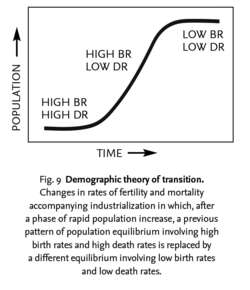
demographic transition
the changes in levels of fertility (see FERTILITY RATE) and mortality (see DEATH RATE) accompanying INDUSTRIALIZATION, which lead one pattern of population equilibrium, characteristic of preindustrial societies, to be replaced by a different equilibrium, characteristic of mature industrial societies.This transition is held to involve three phases (see Fig. 9):
- a preindustrial phase, a situation in which high birth rates are balanced by high death rates, a position of rough equilibrium;
- an intermediate phase, in which death rates fall but birth rates remain high, a phase of rapid population growth;
- a concluding phase, in which birth rates fall, leading to a new equilibrium.
Explanations usually advanced for this pattern of population change are: improvements in public health in phase (b), followed by changes in economic and cultural orientations in phase (c), leading to a reduction in preferred family size.
If this pattern of demographic change can be taken as characterizing the classic historical process of industrialization, the question that today arises is whether the pattern is likely to be repeated in newly industrializing societies, or other contemporary societies undergoing MODERNIZATION. In many of these societies rates of population growth, and levels of social disruption, have been greater than in the middle phase in earlier European patterns of demographic transition. In some societies significant economic growth has been difficult to achieve, and population growth has not been associated with improvements in living standards. It remains to be seen whether a new equilibrium will be established under these very different circumstances.